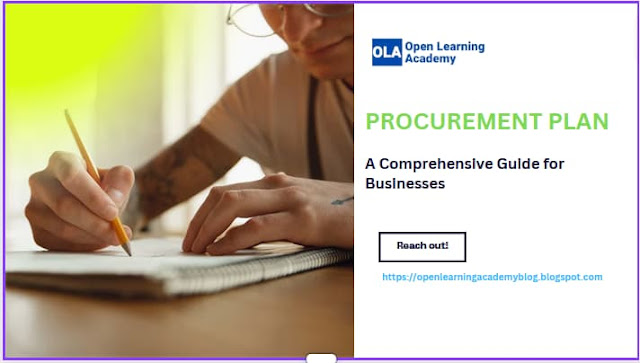Procurement is an essential aspect of business operations. It involves acquiring goods and services from external sources to meet the company's needs. A procurement plan is a critical document that outlines how the organization will acquire the necessary goods and services to achieve its objectives. This article will provide a comprehensive guide to creating an effective procurement plan.
What is a Procurement Plan?
A procurement plan is a document that outlines how a business will obtain the goods and services it needs to operate. The plan describes the procurement process, identifies the procurement needs, and details how the organization/company will select and work with suppliers to meet those needs.
Why is a Procurement Plan Important?
An effective procurement plan is critical to the success of any business. It provides a roadmap for acquiring the necessary goods and services at the right time, quantity, quality, and price. A procurement plan also helps to minimize procurement-related risks, such as late delivery, poor quality, or supplier non-compliance.
Steps in Developing a Procurement Plan
A well-designed procurement plan should cover the following steps:
Step 1: Define the Scope of Procurement
The first step in developing a procurement plan is to define the scope of procurement. This involves identifying the goods and services the company needs to operate and determining the timeframes for procurement.
Step 2: Identify the Procurement Needs
Once the procurement scope is defined, the next step is to identify the procurement needs. This involves determining the quantity and quality of goods and services required and any technical or functional specifications.
Step 3: Develop a Procurement Schedule
After identifying the procurement needs, the next step is to develop a procurement schedule. This includes identifying the procurement milestones, such as when to issue requests for proposals (RFPs) or when to receive the goods or services.
Step 4: Determine the Procurement Methods
The procurement method is a critical aspect of procurement planning. It involves deciding on the best approach to procure the goods and services required. The procurement method can be competitive or non-competitive, depending on the needs and requirements of the business.
Step 5: Identify Potential Suppliers
Once the procurement method is determined, the next step is to identify potential suppliers. This involves researching and identifying suppliers who can provide the required goods and services.
Step 6: Evaluate and Select Suppliers
The supplier evaluation and selection process involves assessing potential suppliers against predetermined criteria, such as quality, price, delivery time, or past performance.
Step 7: Develop Contract Terms and Conditions
After selecting the suppliers, the next step is to develop contract terms and conditions. This involves agreeing on the price, delivery time, quality, warranties, and any other contractual terms and conditions.
Procurement Plan Templates
Procurement plan templates are available to help businesses create a procurement plan. These templates provide a structure for developing a comprehensive and effective procurement plan.
Best Practices for Procurement Planning
To develop an effective procurement plan, businesses should follow these best practices:
- Involve stakeholders in the procurement planning process
- Define procurement needs clearly and in detail
- Use objective criteria to evaluate and select suppliers
- Develop a procurement schedule that meets the needs of the business
- Consider sustainability
Challenges of Procurement Planning
Procurement planning comes with its fair share of challenges. These challenges can include a lack of internal resources, inadequate supplier capacity, changing business needs, and supplier non-compliance, among others.
Benefits of an Effective Procurement Plan
A well-designed procurement plan can benefit businesses in several ways. It can help businesses to:
- Obtain goods and services at the right time, quantity, quality, and price
- Better "Value for Money"
- Minimize procurement-related risks
- Ensure compliance with regulations and ethical standards
- Enhance supplier relationships and partnerships
- Improve operational efficiency and effectiveness
Conclusion
In conclusion, procurement planning is a critical aspect of business operations. A procurement plan helps businesses to acquire goods and services at the right time, quantity, quality, and price. Developing an effective procurement plan involves defining the procurement scope, identifying procurement needs, developing a procurement schedule, determining procurement methods, identifying potential suppliers, evaluating and selecting suppliers, and developing contract terms and conditions. While procurement planning comes with its challenges, businesses can benefit from an effective procurement plan in many ways.
FAQs
1. What is a procurement plan?
A procurement plan is a document that outlines how a business will obtain the goods and services it needs to operate.
2. Why is a procurement plan important?
A procurement plan is important as it provides a roadmap for acquiring the necessary goods and services at the right time, quantity, quality, and price. It also helps to minimize procurement-related risks and ensure compliance with laws and regulations.
3. What are the steps in developing a procurement plan?
The steps in developing a procurement plan include defining the scope of procurement, identifying procurement needs, developing a procurement schedule, determining procurement methods, identifying potential suppliers, evaluating and selecting suppliers, and developing contract terms and conditions.
4. What are the benefits of an effective procurement plan?
An effective procurement plan can help businesses to obtain goods and services at the right time, quantity, quality, and price, minimize procurement-related risks, ensure compliance with laws and regulations, enhance supplier relationships and partnerships, and improve operational efficiency and effectiveness.
5. What are the challenges of procurement planning?
The challenges of procurement planning can include a lack of internal resources, inadequate supplier capacity, changing business needs, and supplier non-compliance, among others.


